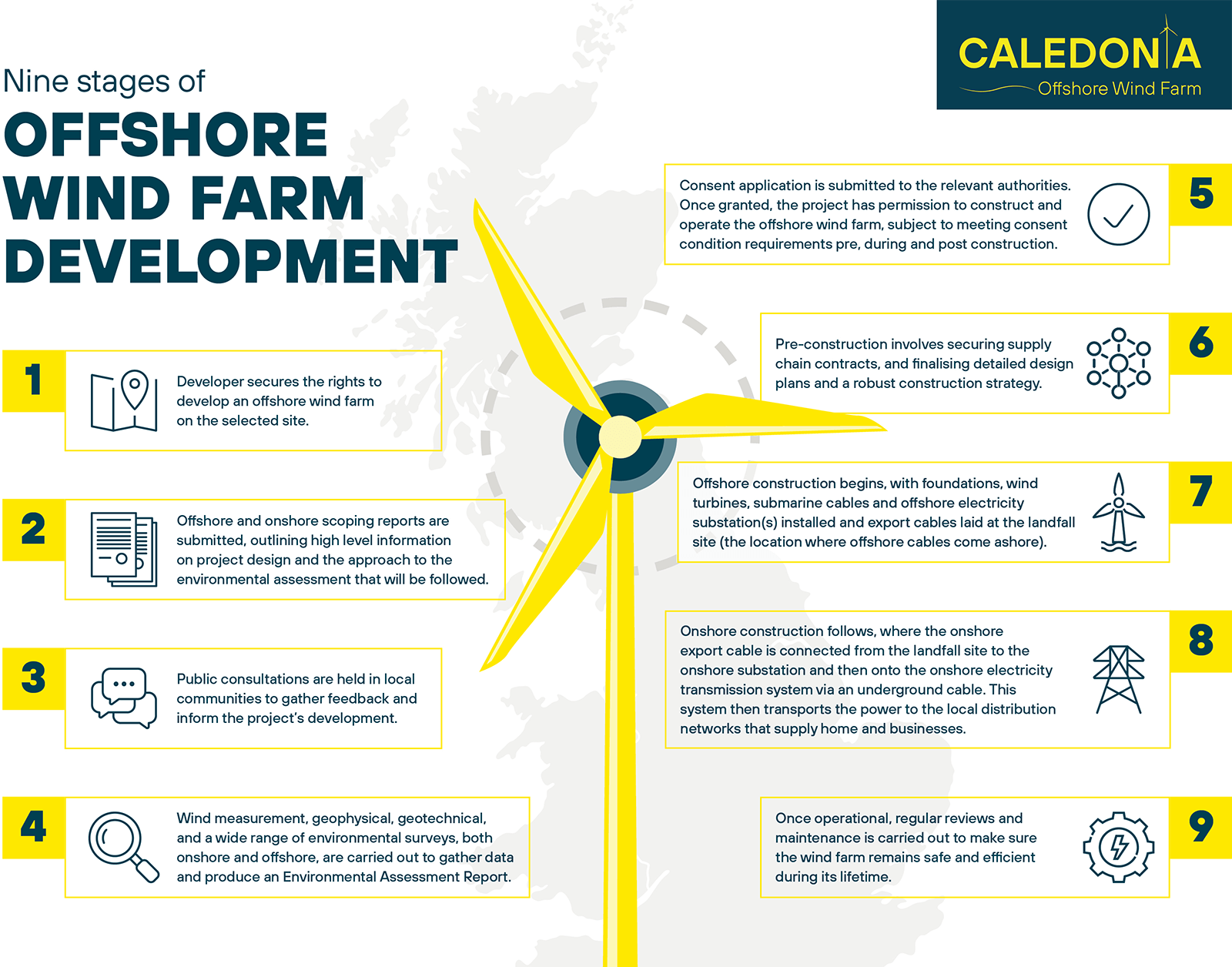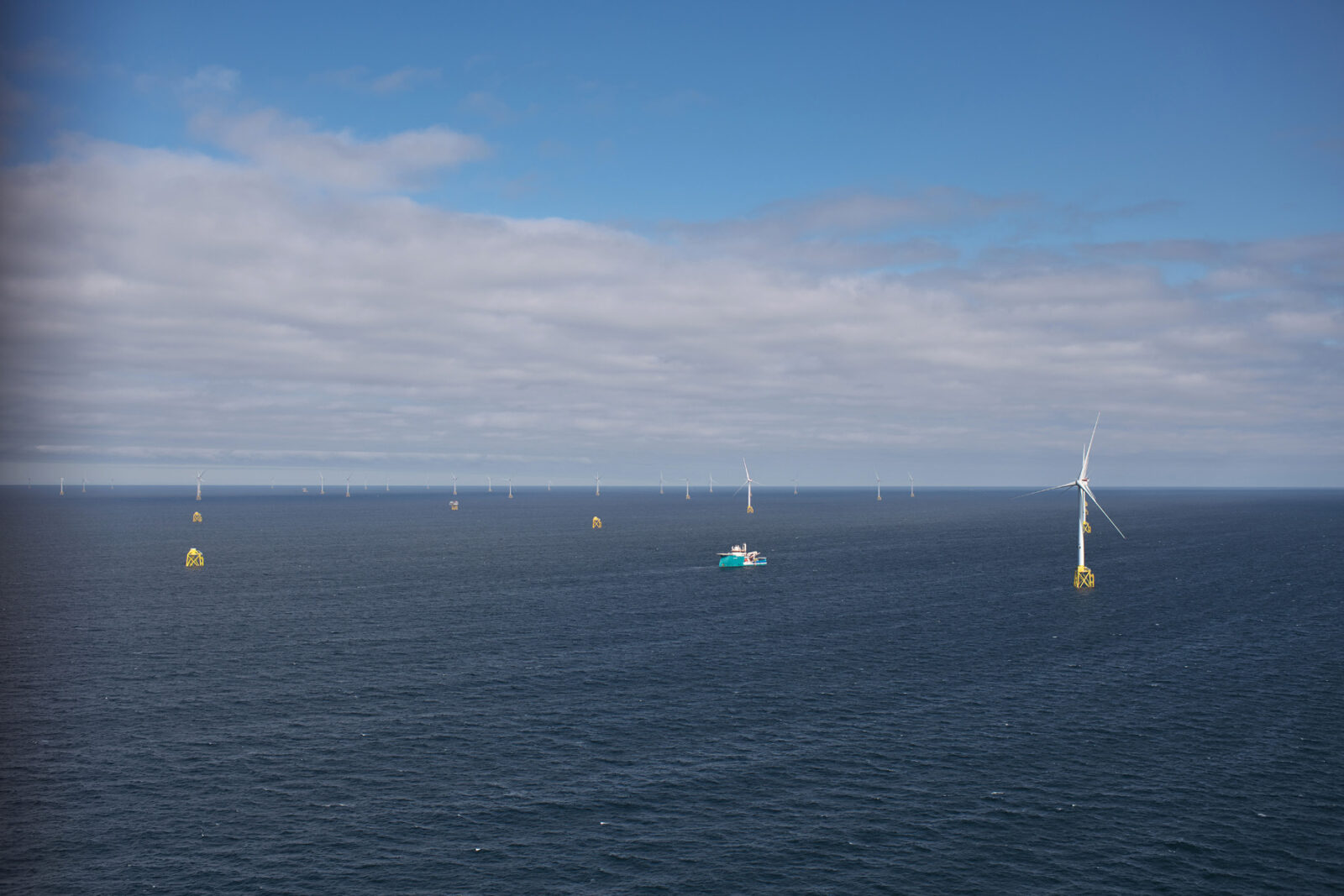Building an offshore wind farm requires significant planning, time and expertise.
Our team has over a decade of experience in the design, development, construction and operation of offshore wind projects in Scotland and further afield.
Discover how we use our skills and knowledge at various stages of the development to successfully deliver an offshore wind farm in this timeline which brings the process to life.

1. The Starting Point
Most offshore wind farms begin in an early feasibility assessment phase. During this period, assessments are carried out by the developer to establish the viability, profitability and positive impact of the planned offshore wind project.
In January 2022, Ocean Winds was awarded the NE4 site (defined by Scottish Government through the Marine Spatial Planning Process) as part of the ScotWind leasing process. An Option for Lease with Crown Estate Scotland was then signed, providing Ocean Winds the rights to develop offshore wind generation on the site in the Moray Firth, now named Caledonia Offshore Wind Farm.
2. Development
Once a site has been agreed, the project moves onto the development phase. This involves:
- identifying the technologies being considered
- undertaking the necessary environmental assessments
- developing plans for the transmission infrastructure which will connect the wind farm to the existing onshore electricity transmission system, which will transport electricity produced to where it can be used.
The development stage is also when the project applies for a grid connection, an onshore connection point is then offered by National Grid confirming where the project will connect to it. Once the grid connection point is confirmed by National Grid, the project team considers where the optimum landfall, underground cable route and substation should be located, based on technical feasibility, environmental considerations, regulatory requirements and community interests.
At the beginning of the development phase, the project will produce offshore and onshore scoping reports, which are submitted to the relevant authorities, such as local government and environmental agencies. These reports set out the approach to the EIA and provide high level information on project design.
Public consultation is also carried out, usually through events in areas local to the project as well as on an online portal. This gives local communities the opportunity to learn more and provide feedback and input on the development.
Gathering data and environment assessments
Next, the project team gathers data to better understand the offshore and onshore sites and the surrounding areas. This includes:
- Deployment of wind measurement buoys (FLiDAR) to measure the site’s wind resource to inform layout.
- Geophysical surveys to understand the shape and profile of the seabed, water depths and technical constraints, and inform safe and efficient design while safeguarding marine ecosystems.
- Geotechnical surveys to analyse soil composition, strength, and stability to help engineers better understand seabed conditions and properties, crucial when designing robust turbine foundations that can withstand marine environments.
- Other offshore environmental surveys, such as seabird, benthic and sediment sampling, navigation and fisheries surveys to understand the environmental sensitivities of the project site and wider area.
- Onshore ecological surveys to identify and classify different habitat types and species present, alongside watercourse characterisation, traffic and transport, archaeological and noise surveys. These surveys help to refine the design approach and location of onshore infrastructure, with the aim to minimise potential environmental impacts as far as possible.
This data is collated and analysed to produce the project’s Environmental Impact Assessment Report (EIAR) and consent application.
Consenting
After the EIA, initial design work and public consultations are complete, the project then submits its consent applications to the consenting authorities. These are the same authorities that received the scoping reports earlier in the project. Once approved, the project then has permission to construct and operate the wind farm to the parameters outlined in its application subject to meeting consent condition requirements.
3. Pre-Construction
Once consent is granted, the pre-construction phase begins. This involves:
- Finalising detailed design plans
- Developing a robust construction strategy
- Securing contracts with supply chain companies
- Obtaining financial closure for the project
4. Construction
Next comes construction, which includes the installation of the onshore and offshore infrastructure that will enable the wind farm to operate, as well as commissioning and connection to the onshore electricity transmission system. This involves:
- Installing the foundations, wind turbines and offshore electricity substation(s), and laying the submarine cables to connect the two
- Laying the offshore export cables at the landfall site (the location where the offshore cables come ashore)
- Connecting the onshore export cable from the landfall site to the onshore substation via an underground cable route
- Connecting the onshore substation via a cable route to the onshore electricity transmission system
- The transmission system then transports the power to the local distribution networks that supply homes and businesses
5. Operation
Once the wind farm is constructed and connected to the onshore electricity transmission system, it enters its operation and maintenance phase which involves:
- Monitoring the performance of the turbines and other infrastructure
- Regular maintenance and repairs to ensure reliability and safety of wind farm
- Discharging operation related consent conditions
So, what’s next for Caledonia?
Caledonia is in the process of finalising its offshore and onshore consent applications, which will be submitted to the Scottish Government Marine Directorate and Aberdeenshire Council later this year.
Ahead of this, Caledonia held its final round of public consultation events in venues across Aberdeenshire, Moray and the Highlands to gather local feedback on development plans in April.
Once consent is granted, the project will move to the final development and construction phases, with the target of being operational and providing energy to over 2 million homes from 2030.

